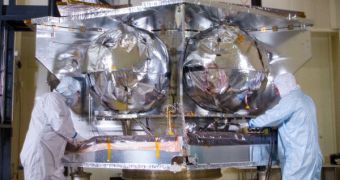One of the most important missions currently in the works at NASA is the Juno probe, a spacecraft that is destined to fly to the gas giant Jupiter in August 2011. The robotic explorer will feature nine scientific experiments, which will help experts gain more insight into how the early solar system appeared and developed, in addition to extra data about the planet itself. NASA officials announce that the assembly, testing and launch operations phases of the mission have just begun on April 1, in a clean room at the Denver, Colorado-based Lockheed Martin Space Systems.
According to NASA plans, Juno is to reach its destination in July 2016, after having flown through the inner solar system for more than 5 years. Once in orbit around Jupiter, it will spend a scheduled year mapping the magnetic and gravity fields that develop around the planet, revealing its deep structure, looking deeper into its thick atmosphere, and also measuring its composition, temperature, cloud motions and other properties. It is currently estimated that Juno will perform about 32 orbits around the gas giant before its officially-allotted mission time expires.
If the NASA Cassini spacecraft, currently in orbit around Saturn, is any indication, then the Jupiter explorer will most likely spend a lot more time around its destination as well. “We're excited the puzzle pieces are coming together. We're one important step closer to getting to Jupiter,” explains Juno principal investigator Scott Bolton, who holds an appointment at the San Antonio, Texas-based Southwest Research Institute (SwRI). He adds that Lockheed Martin engineers will spend the next few months outfitting the spacecraft with all of its components, before finally testing it to see whether it's space-worthy or not.
One giant challenge associated with developing a mission bound for Jupiter is to create shields that would protect the delicate electronic circuits aboard the scientific instruments from the planet's numerous and powerful radiation belts. “We plan to be doing a lot of testing in the next few months. We want to make sure the spacecraft is ready for the long journey to Jupiter and the harsh environment it will encounter there,” explains NASA Jet Propulsion Laboratory Juno project manager Jan Chodas. The JPL, based in Pasadena, California, manages the mission for the NASA Science Mission Directorate, in Washington, DC.

 14 DAY TRIAL //
14 DAY TRIAL //